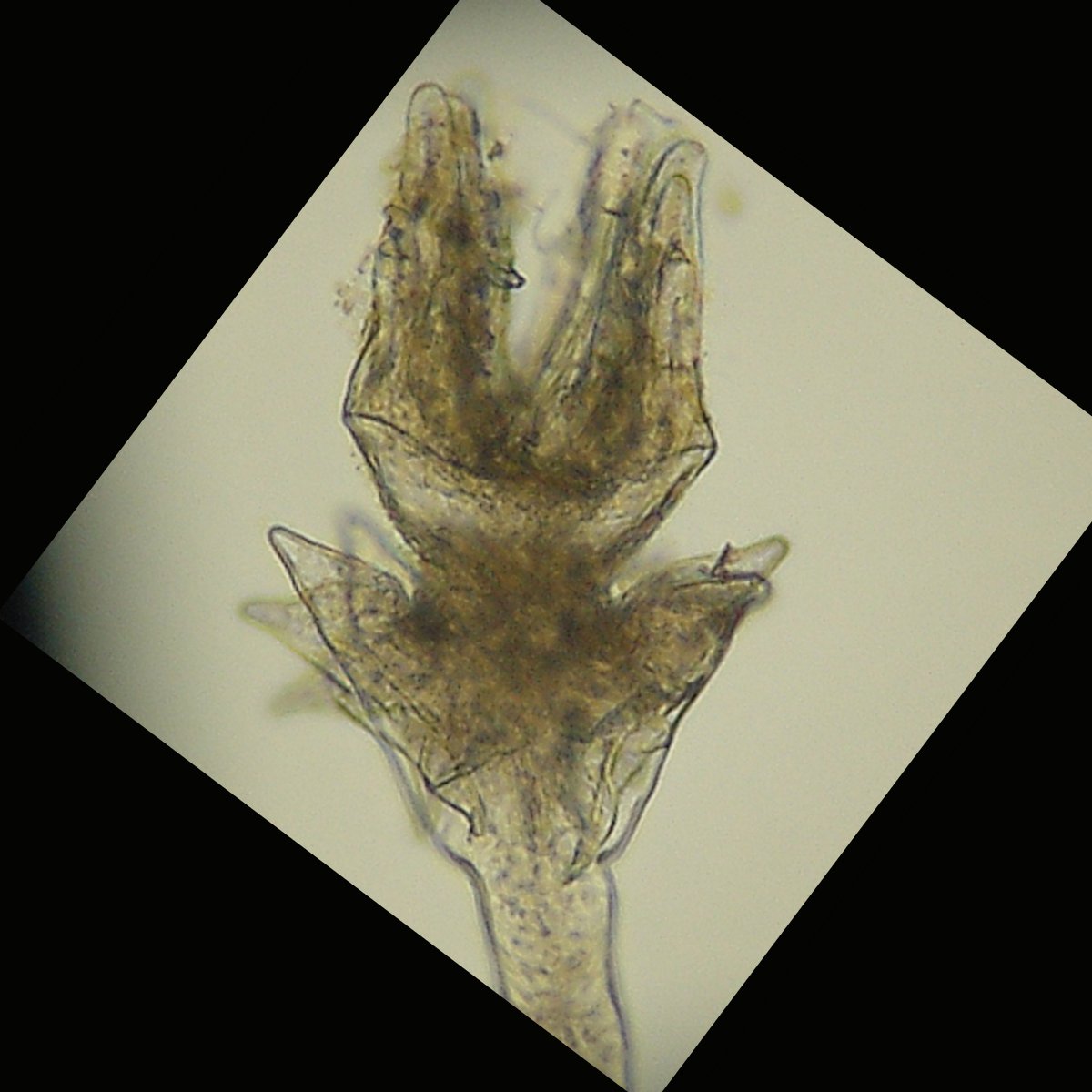Invasion History
First Non-native North American Tidal Record:First Non-native West Coast Tidal Record:
First Non-native East/Gulf Coast Tidal Record:
General Invasion History:
None
North American Invasion History:
Description
Hydroides mucronatus is a tube-dwelling polychaete which is relativel poorly known. Similar forms, identified as H. cf. mucronatus my be conspecific, or may be a closely related species (Bastida-Zavala et al. 2000; astida-Zavala et al. 2002).. The tubes are fragile, and have been lost in many specimens. Some of the tubes have longitudinal ridges or transverse ridges, or no ridges. Serpulids have a feathery crown of modified prostomial palps, called radioles (the prostomium is the first segment, projecting above the mouth). The radioles can be folded and withdrawn into the tube. One of tne of the radioles is modified to form an operculum, which acts as a plug when the animal contracts. The peristomium (segment behind the mouth) is folded back to form a collar, which bears uniramous parapodia, with a distinctive set of collar chaetae, with spines or serrations.The collar is the first of seven thoracic chaeta-bearing segments (chaetigers). The subsequent segments have biramous parapodia. The dorsal branch of the parapodium is called the notopodium; the ventral isne the neuropodium. Chaetae in the two branches and along the body can vary greatly in their morphology, which can be critical in the taxon (wong et al. 2014). \The branchial (gill) crown consists of about 4 to 7 pairs of radioles, on the left and right sides of the mouth. .. The peduncle is cylindrical. The opercular funnel has 14 radii with pointed tips. The verticil has 7 straight spines (8-14). The verticil lacks a central tooth. In H. cf. mucronatus, the funnel is incomplete, and has 4 globular proocesses. The collar chaetae:are bayonet chaetae, with 3-4 blunt-rounded to short teeth at their base, and a smooth distal blade. The thorax has six chaetigers bearing short, rasp-like setae, called uncinae, and hooded limbate chaetae. The abdomen has about 89 segments (69-119, n=4). The overall length is about 2.2. mm for H. mucronatus, but 7.9 mm (4.2-11.6, n=10) for H. cf. mucronatus. The worm is beige pr yellow to light brown. (Description from Bastida-Zavala et al. 2002; Bastida-Zavala et al. 2002).
Taxonomy
Taxonomic Tree
| Kingdom: | Animalia | |
| Phylum: | Annelida | |
| Class: | Polychaeta | |
| Subclass: | Palpata | |
| Order: | Canalipalpata | |
| Suborder: | Sabellida | |
| Family: | Serpulidae | |
| SubFamily: | Serpulinae | |
| Genus: | Hydroides | |
| Species: | mucronotatus |
Synonyms
Potentially Misidentified Species
Ecology
General:
Hydroides mucronatus occurs in seagrass beds, rocks, shells, and dead corals (Batida-Zavala 2000; Batida-Zavala and Ten Hove 2002). The life history and ecology of this wom is little known, but it probably resembles that of other serpulid polychaetes,
Food:
Phytoplankton, detritus
Trophic Status:
Suspension Feeder
SusFedHabitats
| General Habitat | Marinas & Docks | None |
| General Habitat | Coarse Woody Debris | None |
| General Habitat | Grass Bed | None |
| General Habitat | Coral reef | None |
| General Habitat | Rocky | None |
| Salinity Range | Polyhaline | 18-30 PSU |
| Salinity Range | Euhaline | 30-40 PSU |
| Tidal Range | Subtidal | None |
| Vertical Habitat | Epibenthic | None |
Tolerances and Life History Parameters
| Maximum Length (mm) | 11.6 | None |
| Broad Temperature Range | None | Subtropical-Tropical |
| Broad Salinity Range | None | Polyhaline-Euhaline |
General Impacts
Regional Distribution Map
| Bioregion | Region Name | Year | Invasion Status | Population Status |
|---|---|---|---|---|
| CAR-I | Northern Yucatan, Gulf of Mexico, Florida Straits, to Middle Eastern Florida | 1958 | Native | Established |
| CAR-IV | None | 0 | Native | Established |
| CAR-II | None | 0 | Native | Established |
| CAR-III | None | 0 | Native | Established |
| SEP-H | None | 2008 | Non-native | Established |
| PAN_PAC | Panama Pacific Coast | 2008 | Non-native | Established |
| PAN_CAR | Panama Caribbean Coast | 0 | Native | Established |
Occurrence Map
| OCC_ID | Author | Year | Date | Locality | Status | Latitude | Longitude |
|---|
References
Bastida-Zavala, J. Rolando; Ten Hove, Harry A. (2002) Revision of Hydroides Gunnerus, 1768 (Polychaeta: Serpulidae) from the Western Atlantic region., Beaufortia 52(9): 103-178Bastida-Zavala, Jose Rolando; Salazar-Vallejo, Sergio (2000) Serpulidos (Polychaeta: Serpulidae) del Caribe norocidental: Hydroides Y Serpula, Revista de Biologia Tropical 48(4): 841-858
Wong, Eunice; Kupriyanova, Elena K.; Hutchings, Pat; Capa, María; Radashevsky, Vasily; ten Hove, Harry A. (2014) A graphically illustrated glossary of polychaete terminology: invasive species of Sabellidae, Serpulidae and Spionidae, Memoirs of Museum of Victoria 71: 327-342
